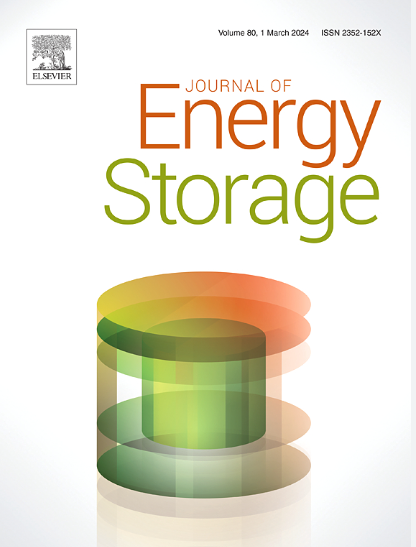A study on the cooling characteristics of radiator for battery hot spots based on temperature hydrogel adaptive valve
IF 8.9
2区 工程技术
Q1 ENERGY & FUELS
引用次数: 0
Abstract
As lithium-ion batteries (LIBs) continue to see pervasive application, the safety issues related to high-temperature accumulation arising from local hot spots have become increasingly critical. Therefore, the development of adaptive cooling measures and temperature management strategies is paramount. This study delves into a liquid cooling device for LIBs, based on a temperature sensitive hydrogel that adapts its flow control. The heat generated from LIBs at a 1C discharge rate is used as the boundary heat source. This research scrutinizes the effects of different flow rates, hot spot dimensions, and hot spot energy intensities on the cooling performance of the hydrogel-infused flow control plate. The results show that, compared with traditional liquid cooling device, the hydrogel augmented device can adjust its hydrogel volume in response to temperature variations, thereby effectively controlling flow distribution and efficiently dissipating heat at hot spot areas. Even with an increase in the hot spot's size and intensity, this adaptive hydrogel-based cooling apparatus maintains a relatively stable maximum temperature and homogeneous temperature distribution. Under various operational conditions, the heat transfer coefficient in scenarios employing the adaptive hydrogel exceeds 8000 W/(m2·K), demonstrating its strong cooling capacity. The results furnish valuable insights into thermal management and provide a solid basis to improve battery safety and promote its commercial applications.
基于温度水凝胶自适应阀的电池热点散热器冷却特性研究
随着锂离子电池(LIB)的广泛应用,与局部热点产生的高温积累有关的安全问题变得日益严峻。因此,开发适应性冷却措施和温度管理策略至关重要。本研究深入探讨了一种用于锂电池的液体冷却装置,该装置基于对温度敏感的水凝胶,可调整其流量控制。锂离子电池在 1C 放电速率下产生的热量被用作边界热源。本研究仔细研究了不同流速、热点尺寸和热点能量强度对注入水凝胶的流量控制板冷却性能的影响。结果表明,与传统的液体冷却装置相比,水凝胶增强装置可根据温度变化调节水凝胶体积,从而有效控制流量分布,并高效地对热点区域进行散热。即使热点的大小和强度增加,这种基于水凝胶的自适应冷却装置也能保持相对稳定的最高温度和均匀的温度分布。在各种运行条件下,采用自适应水凝胶的方案的传热系数超过了 8000 W/(m2-K),显示了其强大的冷却能力。这些结果为热管理提供了宝贵的见解,并为提高电池安全性和促进其商业应用奠定了坚实的基础。
本文章由计算机程序翻译,如有差异,请以英文原文为准。
求助全文
约1分钟内获得全文
求助全文
来源期刊

Journal of energy storage
Energy-Renewable Energy, Sustainability and the Environment
CiteScore
11.80
自引率
24.50%
发文量
2262
审稿时长
69 days
期刊介绍:
Journal of energy storage focusses on all aspects of energy storage, in particular systems integration, electric grid integration, modelling and analysis, novel energy storage technologies, sizing and management strategies, business models for operation of storage systems and energy storage developments worldwide.
 求助内容:
求助内容: 应助结果提醒方式:
应助结果提醒方式:


